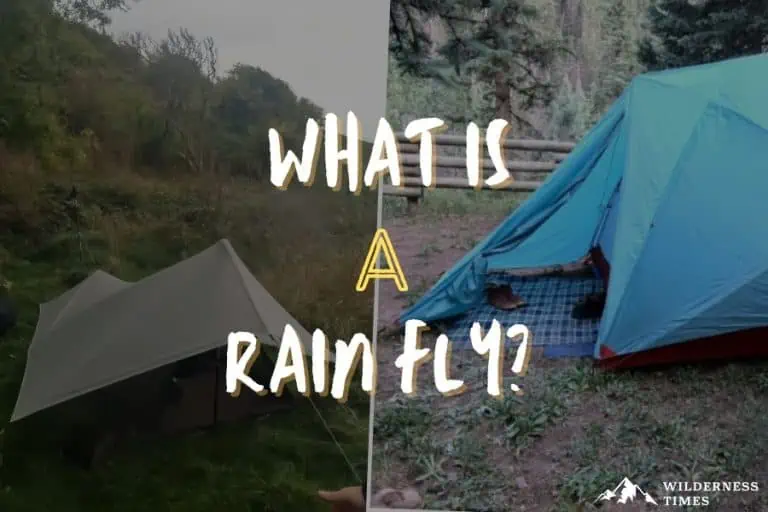We’ve all been there…You get to camp. You start to set up your tent…and it starts to rain.
Well, thank goodness for your rain fly! This great piece of gear is essential for every camper.
If you’re wondering what a rain fly is, it is a layer of water-resistant fabric that goes over the larger tent structure.
In this article, we’re going to discuss all-things rain flies – including why you need one at every campout.
Let’s get into it!
Table of Contents
ToggleThe Different Types Of Rain Flies
While the rain fly’s main purpose is to keep your tent protected from rain, it can also provide you with other advantages.
Not only can they protect from rain, wind, UV rays, and rogue debris, they can also add to your tent’s stability, insulation, and privacy.
In some cases, rain flies even include a vestibule on the front, sides, or back of your tent, adding to your outdoor covered space.
Because of their variety of benefits, there are multiple types of rain flies to choose from.
In this section, we’ll go through the three main types and discuss their advantages.
Full-Coverage Rain Flies
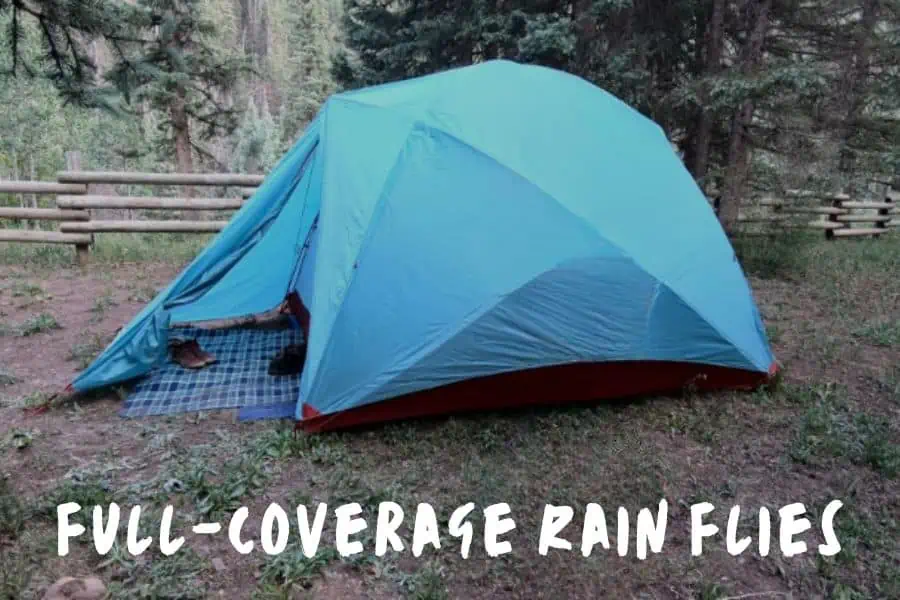
The most common type of rain fly are full-coverage rain flies. These will give you the most protection from rain and the elements.
As the name suggests, this type of rain fly will attach to or cover the majority of your tent. It will also usually include a vestibule on the front, side, or back of the tent.
This type of rain fly will give you the most advantages. It provides weather and UV protection, as well as additional privacy from surrounding campers.
Another important factor that full-coverage rain flies offer is insulation.
When set up properly, there will be a small space between the rain fly and the tent, which establishes a layer of air around the entire tent.
This layer of air will warm up with body heat, which the rain fly traps.
This creates a warm and cozy environment for sleeping.
Roof-Only Rain Flies
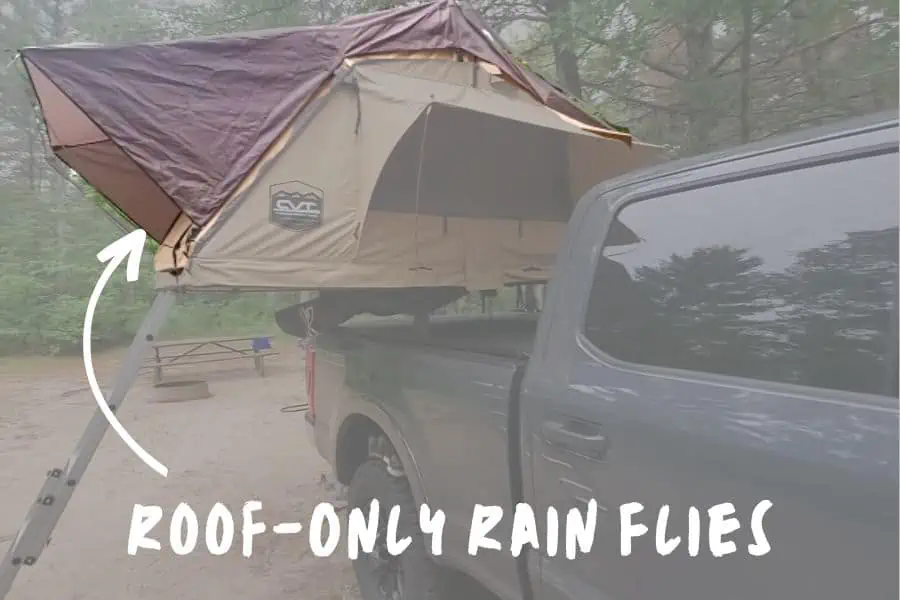
Roof-only rain flies are made specifically to fit only the top portion of a tent.
Because these rain flies only cover the top of a tent or area, they are generally smaller in size.
Therefore, they will be less effective in protecting from rain, wind, and other elements.
However, these rain flies are great for creating ventilation, since they leave more space for air to circulate.
In some cases, roof-only rain flies can be used on roof-top tents or tents that are attached to the roof of your vehicle.
In these cases, the rain fly will fit over the top of the tent to protect it from unfortunate weather conditions.
Ultralight Rain Flies
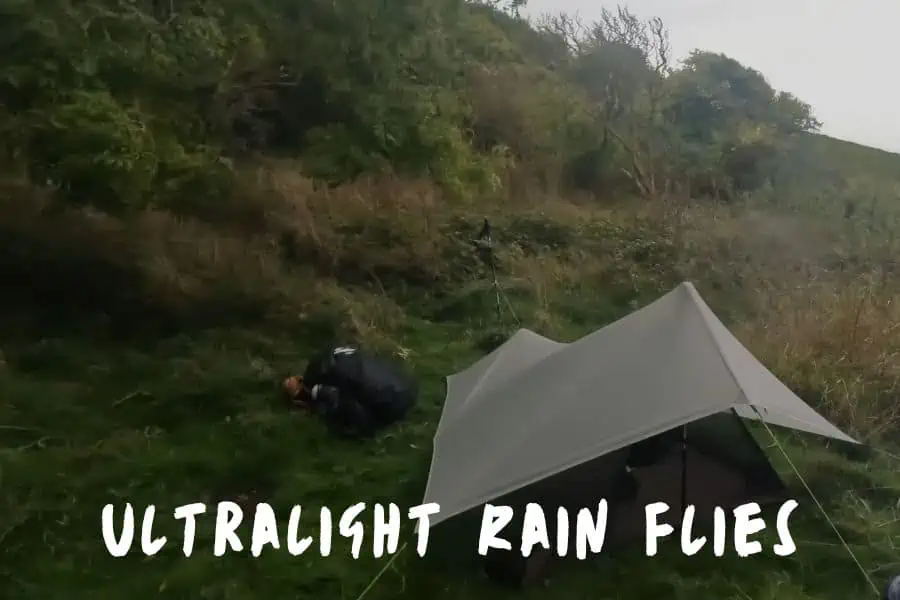
While similar in design to a tarp, ultralight rain flies are significantly lighter and are much easier to carry over long distances.
However, some of their lightweight qualities are caused by sacrificing coverage and effectiveness.
While ultralight rain flies will stand up to moderate weather conditions, they are less effective in severe weather.
Many ultralight rain flies are also freestanding, rather than compatible with a specific tent.
Because ultralight flies don’t attach to tent structures, they aren’t as effective at trapping a consistent layer of air between it and the tent.
Therefore, they are less effective at creating insulation.
Due to their freestanding nature, ultralight rain flies are also less effective at creating privacy.
While they do cover the top of your tent, they can sometimes leave the front and sides visible to other campers.
How To Properly Use A Rain Fly
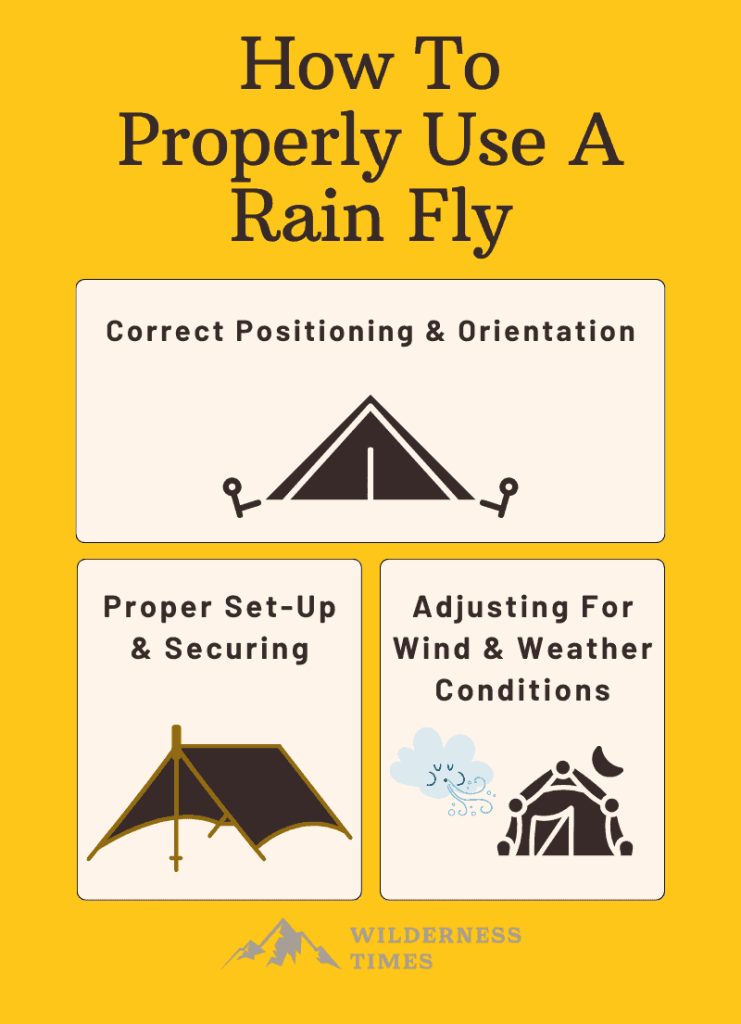
Correct Positioning & Orientation
When setting up your rain fly, make sure that you position it correctly to give you the most coverage. The specifics of this will depend on the type of rain fly you’re using.
For a full-coverage rain fly, I generally match it up with the doors and windows of the tent.
This way, you’ll know you’re putting it on correctly when you start clipping it in.
The same logic applies for roof-only rain flies. Although, I generally line up the corners instead of the doors and windows.
Ultralight rain flies will not match up specifically with most tent designs.
In general, it’s best to set it up over the tent, with the widest section reaching over the sides of the tent to give yourself the most coverage.
Proper Set-Up & Securing
Once you have your rain fly positioned, you’ll need to make sure it’s secure.
For full-coverage and roof-only rain flies, there will be clips on the tent that will attach to the rain fly (or vice versa).
To properly secure the two, you’ll need to attach these clips and stake down any remaining guylines.
You will need to set up ultralight rain flies like you would a tarp, with a cord running through the middle and guylines staked down at the corners.
Adjusting For Wind & Weather Conditions
Since rain flies are the outermost layer of your tent, they are the most likely to be affected by incoming wind and weather.
If you know that unfavorable weather conditions are on the way, make sure that your rain fly is secured to the tent and staked down.
For full-coverage rain flies, you’ll want to make sure that all vents, roll-up sections, and doors are closed and sealed to keep the rain out of the tent interior.
Also See: How Much Wind Can A Tent Withstand?
Maintenance & Care For Your Rain Fly
Cleaning Guidelines
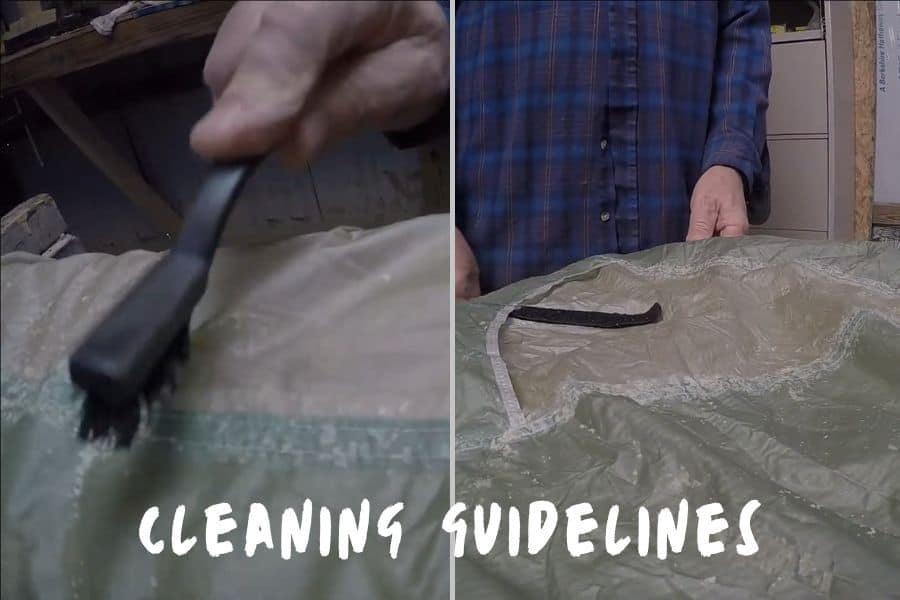
Of your whole tent structure, rain flies are the most likely to get dirty because they stand as a protection layer between your tent and the elements.
You can brush off most dirt and debris with a damp cloth or your hand. But it’s worth it to do a deep clean if your rain fly gets in contact with sand, bird feces, or tree sap.
If you find yourself with a particularly dirty rain fly, you can submerge it in a tub of warm water and gentle, non-detergent soap.
Since rain flies can be quite large, I generally complete my deep cleans in a bathtub or large sink.
Agitate the fabric in the tub with the soap and let it soak for around 10 minutes. At this point, you should see the water start to get dirty.
If the rain fly still appears dirty after this rinse, drain the water from the tub and refill it with new water.
Repeat the process until your rain fly is shiny and new.
Please note: You should NEVER machine wash your tent or rain fly. Machine washing is highly likely to damage your materials and strip them of their water- or UV-resistant coating.
Storage Tips
For the best maintenance, store your rain fly in a clean, cool, dark environment.
Too much exposure to harsh lighting, heat, or residual moisture will damage the materials and shorten the lifespan of your rain fly.
No matter what, always make sure that your rain fly is completely dry before you fold it up for storage.
This will help prevent mold and mildew from growing on the materials.
I usually do this by hanging my rain fly (and tent) out to dry in an outdoor area before packing it up for storage.
Repairing A Damaged Rain Fly
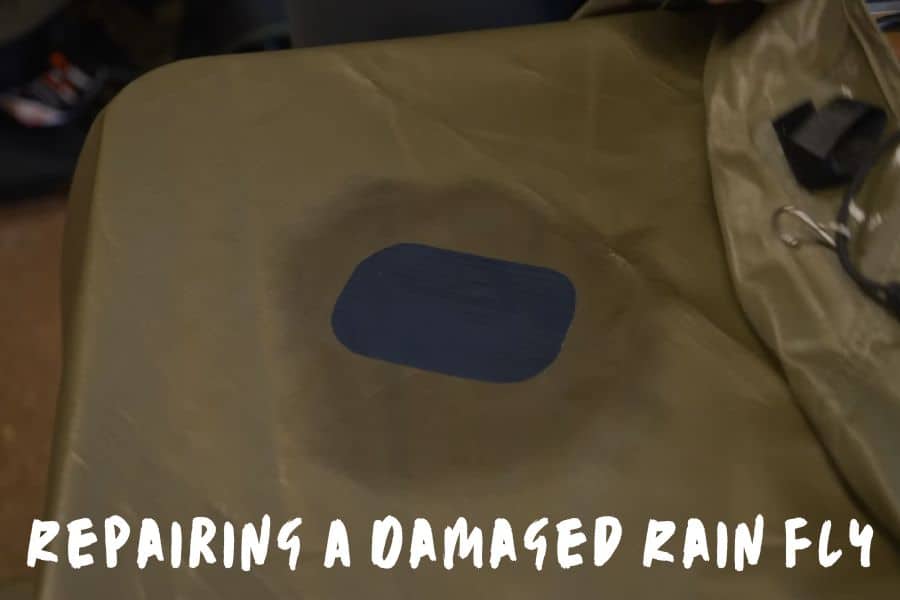
When you’re out on the trail, tears can happen. It’s best to fix rips or holes as soon as possible, so that you don’t risk water leaking into your tent by accident.
I’ve detailed a few options for immediate and long-lasting rain fly repairs below:
First, you can always use duct tape or gaffer (climbing) tape to fix the tear on the trail.
This can actually be a great option both in a pinch and for the long term, depending on the size and severity of the tear.
If it looks like you might need more hardcore repair measures, you can either use tent glue or a sewing kit to repair the rip.
Generally, I bring tape on the trail to fix tears for the trip, and then apply more extensive measures when I get home.
Pro-tip: Make sure you look at the areas around the seams and zippers of the tent. This is where tears and rips are most likely to appear.
Replacement Tent Rain Fly
If you can’t fix a damaged rain fly, then your next best option will be to buy a replacement for your specific tent model.
But the first thing you’ll want to do is see if your tent is still under warranty.
Many outdoor tent brands have Limited Lifetime and even Lifetime Warranties, so there is an outside chance that the manufacturer can replace the rain fly for you.
And if not, you’ll want to head to the manufacturer’s website to see if they sell the rain fly separately.
But in the event that they don’t, you can always use a tarp.
Pro-top: If all else fails, you can put a tarp over your tent. Here is our guide to how to put a tarp over a tent.
Rain Flies Vs. Tarps
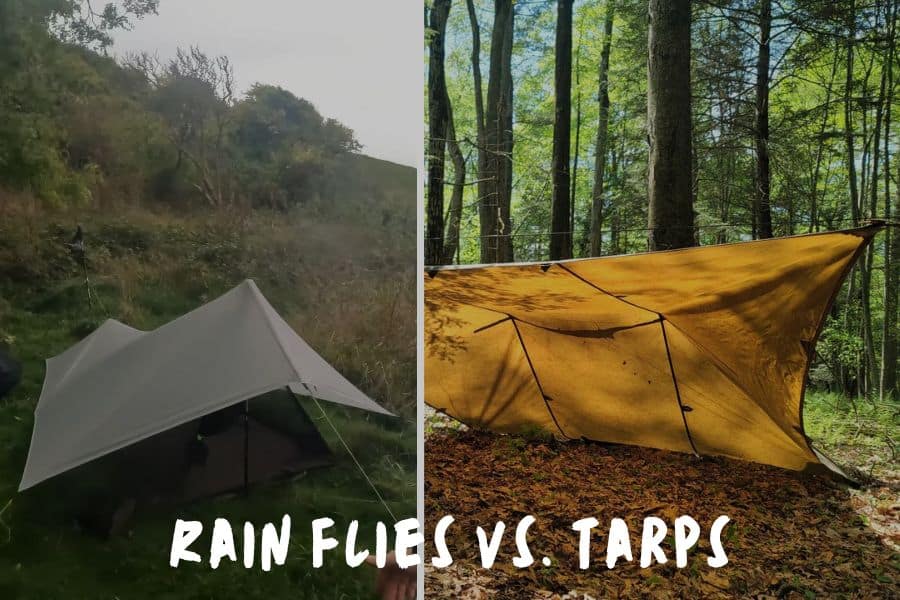
Tarps can be a great, multipurpose tool to bring to a campout. And, of their many purposes, they can also be used as a rain fly or free-standing shelter.
In fact, before rain flies were fitted to your tent design, tarps were how people kept water out of their sleeping area
In general, I prefer the consistency of a full-coverage rain fly and highly suggest using a rain fly over a tarp if one is available to you.
It has advantages in insulation, portability, and more!
However, you can always use a tarp if you’re in a pinch, or camping in good weather with no chance of rain.
Since you’re most likely to be using a full-coverage rain fly, the table below will compare tarp use to that of a full-coverage rain fly.
| Feature | Rain Fly | Tarp |
| Size | The majority of full-coverage rain flies will fit to the size of your tent. | Tarps come in a variety of sizes, depending on your needs. |
| Insulation | Rain flies are generally better at insulation. | Tarps are not designed for specific tent structures, thus less effective at insulation. |
| Coverage | Since the rain fly is fitted for your tent structure, you will get the most effective coverage. | Tarps offer moderate coverage, depending on size. |
| Portability | Rain flies are a portion of your tent’s design and will pack seamlessly in with your other tent supplies. | Tarps will need to be packed up separately from your tent supplies and can be heavier/bulkier to carry. |
| Durability | Rain flies are less durable than most tarps. | Because of the strong materials used, tarps are more durable than rain flies. |
| Multipurpose Use | Since rain flies are fitted specifically for your tent, they have only one use. | Tarps can be used for various purposes, making them a very versatile tool. |
Size
The size of a rain fly will differ depending on the size of the tent.
However, since the rain fly is specifically designed for the tent it’s paired with, you can always be sure that the size will be suitable for the tent’s needs.
Tarps can vary in shapes and sizes.
If you need to use one for tent coverage, be sure that it is big enough to cover your entire sleeping space.
Insulation
Rain flies are more effective at insulation because they are specifically fitted to create a layer of air between the rain fly and tent.
In comparison, tarps are not designed specifically for your tent.
So, while they can maintain some warmth in your tent, they will not be as effective as a rain fly.
Coverage
Since the rain fly is part of the overall design of the tent, it will provide the most coverage.
This includes hiding the mesh on the top and sides of some tents, and protecting those inside from water and debris.
For tarps, coverage will depend on the size of the tarp.
If you are able to bring a tarp large enough to cover the tops and sides of your tent, you can get great coverage.
However, the rectangular shape of a tarp may leave the front and back of your tent exposed to the elements.
Portability
Because rain flies are generally made from the same fabric and design of the tent, they pack in with the tent supplies and are easy to carry on a longer trek.
In comparison, tarps do not pack down as easily and can be slightly heavy and cumbersome to carry in a backpack.
Durability
Rain flies are made from a light material that is usually not as durable as tarp material.
This is because rain flies are designed to compress down in your backpack, so they employ thinner materials.
Tarps are made from a heavy-duty waterproof material that is much more durable.
Because of this, you can rest assured that your tarp can stand up to dirt, rocks, and other debris without ripping.
Multipurpose Use
Tarps are going to shine when it comes to multipurpose use.
Because they are not designed for a specific tent, their rectangular shape is useful for many purposes.
For example, they would be great for ground and hammock coverage.
FAQs
Why Is A Rain Fly Important For Camping?
While you’re on your camping trip, rain flies will keep you protected from the elements and increase your privacy from other campers.
Depending on the size and style of your rain fly, it may also offer you more insulation on cold nights.
Can I Use My Tent Without A Rain Fly?
Your tent will absolutely still function without a rain fly.
However, because the top and sides of tents are generally made with a see-through mesh material, omitting the rain fly will make you vulnerable to the elements and will decrease your privacy.
There is one time I absolutely recommend that you ditch the rain fly, and that’s on a clear night with high visibility.
The lack of a rain fly means you can lie in your tent and sleep under the stars – with a full view of the night sky.
Does A Rain Fly Provide Additional Privacy While Camping?
Because of the added coverage, most rain flies will cover the see-through mesh on the top and sides of the tent, giving you a good amount of privacy.
Additionally, full-coverage rain flies will include vestibules. These will give you additional privacy as you enter and exit your tent.
How Does A Rain Fly Enhance Ventilation In A Tent?
Sometimes, condensation can occur in a tent if there is too much body heat maintained inside the structure.
To prevent these instances, rain flies generally have a series of vents and roll-up sections you can use for cross ventilation.
However, this is generally only an area of concern for full-coverage rain flies.
Ultralight rain flies will not create condensation quite as much.
Their thin structure enhances their ventilation abilities.
What Is The Waterproof Rating On A Rain Fly & Why Is It Important?
Since a rain fly’s main purpose is to keep rain out of your tent, it’s important that the materials used are waterproof.
For rain flies and tents, most waterproof ratings measure the rate at which water is able to pass through the fabric.
This is shown through a millimeter unit.
When buying a rain fly, you want to make sure that your rating is at least 2,000mm.
In Summary
Rain flies are an essential tool to bring on every camping trip.
From full-coverage to ultralight models, I hope you find the rain fly that works the best for your next camping adventure!


